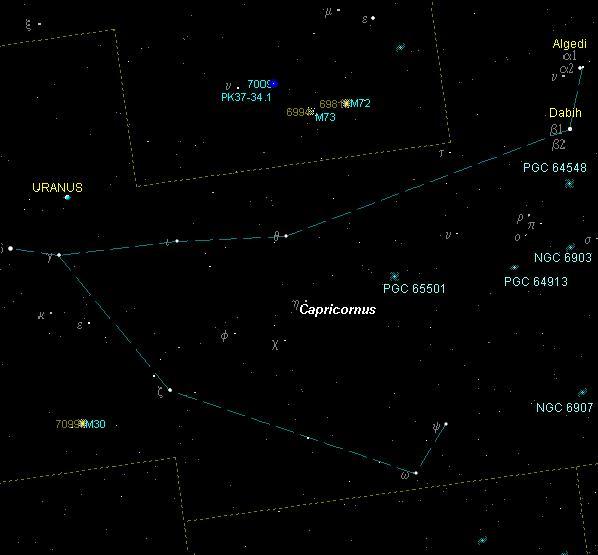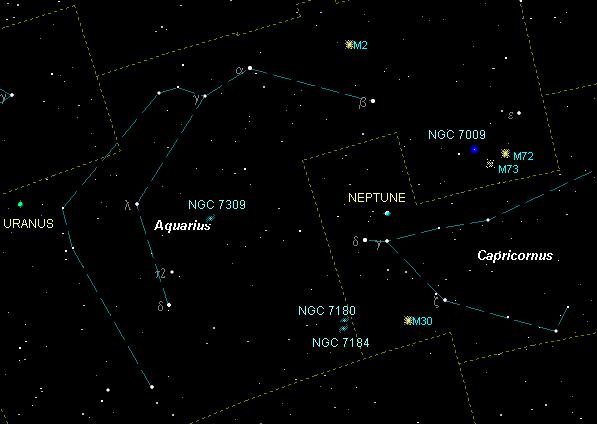Moving up the ecliptic
Alas, short, warm, humid, buggy summer nights are now behind us, only to be replaced with longer, cooler, drier, autumn observing sessions without the hum of mosquitoes. This is the perfect time of year to enjoy the Milky Way high overhead when the sky darkens as well as many summer objects. As the last few months of 2008 tick on by, we will eventually lose sight of the galactic arms. This will also be the final curtain all to view Scorpius and Sagittarius in the south. The heart of our Milky Way Galaxy lies between these two southern icons.
As we continue up the ecliptic to the left of Sagittarius, we find Capricornus the sea-goat. Ranked 40th in size, it consists of 414 square degrees. The asterism is laid out with 3rd and 4th magnitude stars and no prominent suns. Let us first take a look at the star Dabih, otherwise known as Beta Capricorni. It is a nice double star separated by three arc minutes. The primary - Dabih Major lists as third magnitude while its companion - Dalih Minor (a giant or subgiant) is 6.1. They appear to lie 330 light-years from us and are about 1/3 of a light-year separating the two components. Dalih Minor shines some 40 times that of our Sun.

Only a handful of 13th galaxies resides in this constellation. One such galaxy is NGC 6907 located in the southwestern quadrant. This spiral galaxy appears to have a structure to it. Astronomers now believe that this structure is a result of a merger with a smaller galaxy NGC 6908, seen in the left arm. The colliding galaxy is an S0 elliptical that has no arm structure to it. These galaxies lie about 140 million ly from us.
Capricornus also plays home to the planet Neptune. Appearing as a slightly bluish hue in a telescope, Neptune is 17 times more massive than Earth and is the fourth-largest planet orbiting the Sun. Neptune possesses some 13 moons including the largest – Triton at 2,700 km wide. At magnitude 7.9, Neptune can be located with binoculars or a telescope. It takes a little more than four hours for its light (reflected from the Sun) to reach us.
Moving to Capricornus’ left is the constellation Aquarius the water bearer. Owning 980 square degrees of celestial real estate, it ranks 10th in overall size. Three Messier objects lie within its borders, two globular clusters (M2 and M72) and M73 which are only four 10th to 12th magnitude stars located 2,500 light-years away. It seems it made it to the Messier list as Charles catalogued its position when entering the data for M72 – only 1.5 degrees to its west. However, Messier did describe it as nebulous.
M2, on the other hand, is a heavyweight when it comes to globulars. Just at naked-eye visibility on very transparent night, this magnitude 6.5 compact clusters’ population is estimated to be in the order of 150,000 stars. M2 lays 37,500 ly from us and measurements indicate 175 light-years wide. M72 is one of the remote globulars and is small and faint. Estimated distance is 55,000 ly and with a 6.6 arc-second width, this corresponds to a width of 106 light-years. It is dim thought at magnitude 9.3. M72 does possess 42 known variable stars mostly RR Lyrae stars.

A must-see is NGC 7009 aka the Saturn Nebula. Measure 60 arc seconds by 40 arc seconds, NGC 7009 is a planetary nebula with a magnitude 11.5 central star along with an oval shell of luminous gas. At the endpoints of its axis are what appear to be handles – very strange indeed. Observations with large telescopes will reveal its green fluorescent glow.
NGC 7309 is magnitude 12.5, but even though they are large and reveal decent arm structure, they each possess a low surface brightness. The far eastern quadrant of Aquarius is presently home to the planet Uranus – pronounced like “your-an-us”. Discovered in 1781 by William Herschel, it was the first planet discovered with a telescope. If you know where to look in a clear sky, you should be able to find this magnitude 5.7 greenish-blue dot without optical aid.
There are numerous galaxies in Aquarius, but there is a nice contrasting pair. First, we have NGC 7180, an elliptical magnitude 12.5 galaxy with a bright core. However, half a lunar width to its south is NGC 7184 – a 12th magnitude elongated galaxy with a bright core. Even the structure of NGC 7184 is quite intriguing with a beautiful ring circling the nucleus. NGC 7184 is 114 million light-years from us. Imagine how dramatic it would look if it were as close as the Andromeda Galaxy at 2.9 million light-years.
Another oddly shaped galaxy is NGC 7378. Although it is a half magnitude fainter than NGC 7184, it is still worth a look. It has an outer ring but no arm structure.
We end the tour by moving up to the left till you get to Pisces – The Fishes. The Alpha star connecting the two fishes is called Alrescha. Around fourth magnitude Alrescha is a fine but close double star. It might be a challenge splitting the 1.3 arc-second gap. The two components are A0 and A3 stars and vary their spacing from 50 to 190 astronomical units (au) in their 720-year dance around each other. The year 2060 is the expected closest they will be.

M74 is a gem of a galaxy showing a lot of structure. This face-on is listed as magnitude 9.4 and is 35 million light-years away. It measures close to 10 arc minutes across or one-third the moon width in the sky. The arms are peppered with blue stars and pink regions of star formation (HII regions). At 95,000 light-years in width, M74 is roughly the same size as the Milky Way Galaxy. Riding along the northern border with Andromeda is a group of seven galaxies. Five of them are round galaxies and the other two are elongated but are too remote to see detail. They are catalogued as NGC 499, 507, 508, 513, 517, 528 and IC 1685.
The finest galaxy in the area is not in Pisces but just a tad over the eastern. M33 in Triangulum is a huge face-on galaxy that can be glimpsed naked eye from dark sites. M33’s overall diameter is twice that of the full moon and possesses many NGC objects along with its amazing arm structure. As you can see, these three constellations are pretty void of open and globular clusters or even nebulae for that matter. Just galaxies many of which are in the magnitude 14 to 15 range.
| Object | Type | Magnitude | Coordinates |
|---|---|---|---|
| M 2 | Globular cluster | 6.5 | RA:21h 33m 30.0s Dec:-00d 49 |
| M 30 | Globular cluster | 7.5 | RA:21h 40m 23.9s Dec:-23d 11 |
| M 33 | Galaxy | 5.7 | RA:01h 33m 53.9s Dec:+30d 39 |
| M 72 | Globular cluster | 9.4 | RA:20h 53m 30.0s Dec:-12d 32 |
| M 74 | Galaxy | 9.2 | RA:01h 36m 42.0s Dec:+15d 47 |
| NGC 499 | Galaxy | 12.0 | RA:01h 23m 12.0s Dec:+33d 28 |
| NGC 6907 | Galaxy | 11.3 | RA:20h 25m 6.0s Dec:-24d 49 |
| NGC 7009 | Planetary nebula | 8.0 | RA:21h 04m 12.0s Dec:-11d 22 |
| NGC 7171 | Galaxy | 12.3 | RA:22h 01m 0.0s Dec:-13d 16 |
| NGC 7184 | Galaxy | 12.0 | RA:22h 34m 18.0s Dec:-10d 21 |
| NGC 7309 | Galaxy | 12.5 | RA:22h 34m 18.0s Dec:-10d 21 |
| NGC 7378 | Galaxy | 13.0 | RA:22h 47m 53.9s Dec:-11d 49' |
And finally, a sure sign that winter is around the corner is to view the Pleiades (M45) star cluster with the constellation, Orion the Hunter which clears the eastern horizon around midnight local time. But I will leave these winter icons to the winter season. The Orionid meteor shower will peak at 4 hours UT on the 21st. This might be a shower to watch as past events have had interesting results in the number of meteors seen. Normal rates are 20 – 25 meteors per hour but who knows. We do now, however, the glow of the third-quarter moon will mask some of the fainter ones.
The beacon in the west – Venus is slowly making its way up the sky. It will meet up with Jupiter for one last hurrah along with the four-day crescent moon in a few months on December 1st. The planet Mercury attains its greatest western elongation in the morning sky. On the 22nd of the month, it will be at its highest elevation of 18 degrees. This month’s Hunter’s Moon will be on the 14th – Election Day.
Until next month – clear skies everyone.
Gary Boyle
